Daniel Hennelly
Are You Ready for Some Football?
Part III
Now that the 2023 football season has arrived, Postcard History’s readers are ready for a trip across the American South to view college football stadiums captured on postcards. The postcards date from the 1930s through the ‘60s.
Sitting by the Tennessee River in Knoxville, Neyland Stadium (originally named Shields -Watkins Stadium), is the home of the University of Tennessee Volunteers. Constructed in 1921, students aided in completing the stadium when the project ran out of funds.
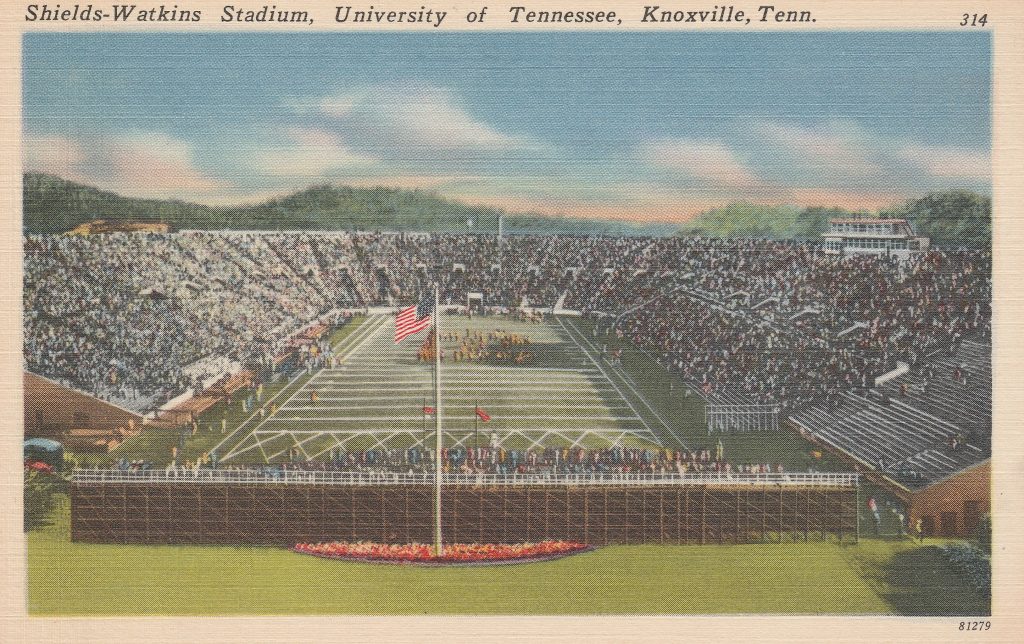
Since that modest beginning, it has undergone sixteen expansion projects to make it the sixth largest stadium in the United States and the eighth largest in the world. Its current seating capacity is 102,455 although the record attendance is 109,061 for a game against the University of Florida in 2004.
Initially Neyland Stadium could accommodate only 3,200 fans along the west sideline, however the capacity increased to 6,800 when stands were erected along the east sideline in 1926. By 1938, successive additions had increased seating to 31,300. In 1948, a south endzone of 15,000 seats gave the stadium a horseshoe shape similar to Harvard’s stadium and now seated 46,290 fans.
Several expansion projects in the 1960s through the 1990s brought the stadium’s capacity to over 100,000. Several renovation projects from 2004 until 2010 costing $200 million were designed to increase fan amenities by adding club and priority seats, executive suites, improved locker rooms, larger press facilities, elevators, additional restrooms, and more concessions.
The Cotton Bowl Stadium is located at the Texas State Fairgrounds in Dallas and played host to the post-season Cotton Bowl Classic from 1937 until 2009. The Cotton Bowl game moved to AT&T Stadium in Arlington, Texas, the home of the Dallas Cowboys, in 2010.
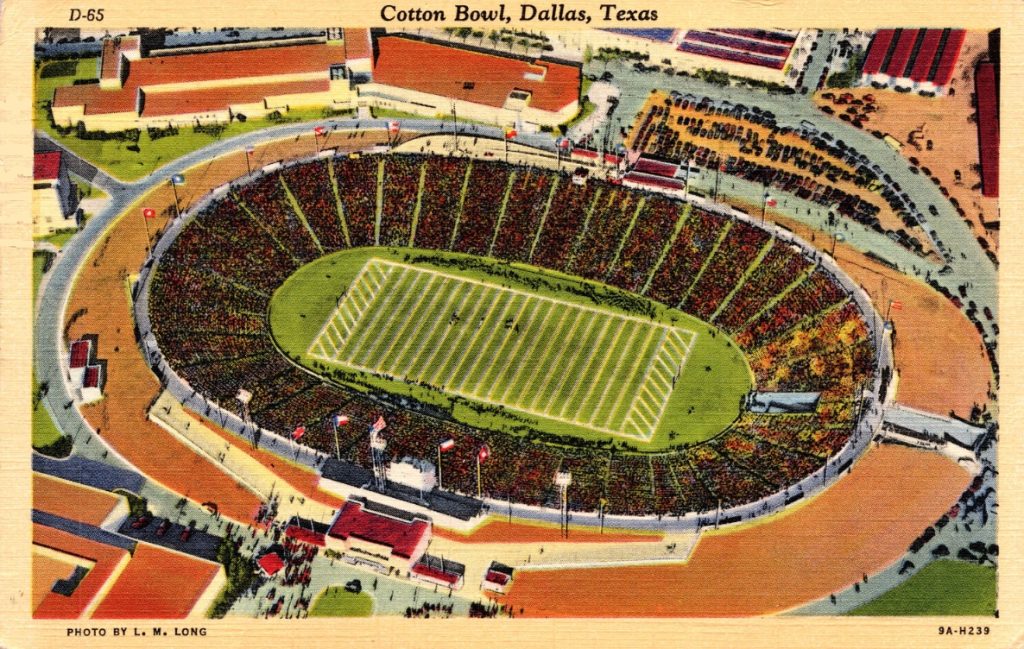
Opened in 1930 and originally named the Fair Park Stadium, it was renamed the Cotton Bowl in 1936. It seated 45,507 fans on backless bench seating. In 1948, a second deck was added to the stadium’s west side, increasing capacity to 67,000 fans. The following year, the east side was double-decked increasing capacity to 75,504. In 1968, the stadium’s capacity decreased to 73,302 when chair back seats were installed. In 2008, the Cotton Bowl underwent a major renovation to improve fan amenities and the seating increased to 92,100.
In addition to the Cotton Bowl Classic, the stadium was the home field of the Southern Methodist University Mustangs from 1932 until 1978, and again from 1995 until 1999. During the 1940s, the stadium had been expanded due to the popularity of SMU halfback, Doak Walker earning it the sobriquet, “The House That Doak Built.” Walker won the Heisman Trophy in 1948 and later played for the NFL Detroit Lions.
The Cotton Bowl hosts the annual Red River Showdown, the annual game between the University of Texas Longhorns and the University of Oklahoma Sooners. Held in “neutral territory” midway between Austin, Texas and Norman, Oklahoma, the game has been played in Dallas since 1929 and held in the Cotton Bowl in 1932. The stadium also hosts the annual State Fair Classic between the Grambling State University Tigers and the Prairie View A&M University Panthers. A battle between the two historically African American universities’ marching bands held at halftime, is as popular as the game. Another game between historically African American universities, the Texas State Fair Showdown, features Texas Southern University Tigers and the Southern University Jaguars.
The Cotton Bowl was home to Dallas Cowboys of the NFL from 1960 until 1971, and the Dallas Texans of the AFL from 1960 until 1962. Due to poor attendance, the Texans moved to Kansas City and were renamed the Chiefs.
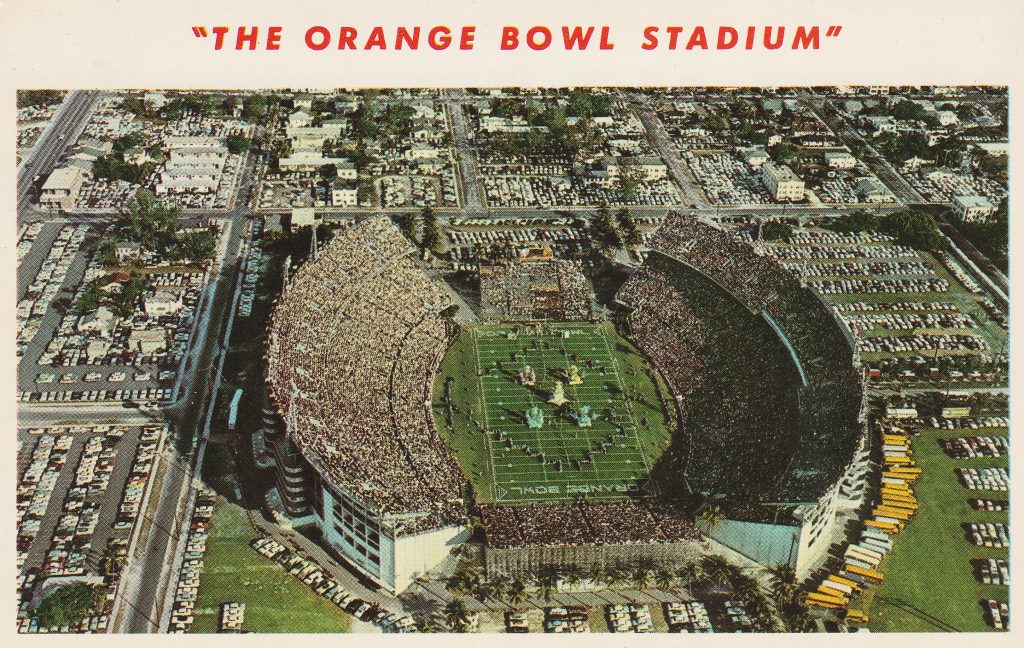
When the Orange Bowl Stadium was completed in 1937, it was named Burdine Stadium after Roddy Burdine, a Miami department store owner and civic leader. Located west of downtown Miami, the Orange Bowl originally seated 23,330. The Orange Bowl was the home of the University of Miami Hurricanes from 1937 until 2007. The first post-season Orange Bowl game was held in 1938 and attracted a crowd of 19,000. Seating was added to the end zones in the 1940s to increase seating to 35,030. In the 1950s, the stadium was double-decked increasing seating to 76,062. In 1968, the west end zone was double-deck to increase seating to 80,010. Seating declined after that as more comfortable seats were installed to increase fan comfort and the seats in the east end zone were removed to install a modern scoreboard.
In 1966, the Orange Bowl became the home of the AFL’’s Miami Dolphins. The Dolphins played there until 1986 when they moved to Joe Robbie Stadium for the 1987 season. It hosted the post-season Orange Bowl Game from 1938 until 1996 and again in 1999. The Orange Bowl was the site of Super Bowls II, III, V, X, and XIII. (It could be that one reason Roman numerals are taught in schools today is so sport fans can keep track of the Super Bowl.) In 2008, the Orange Bowl was razed.
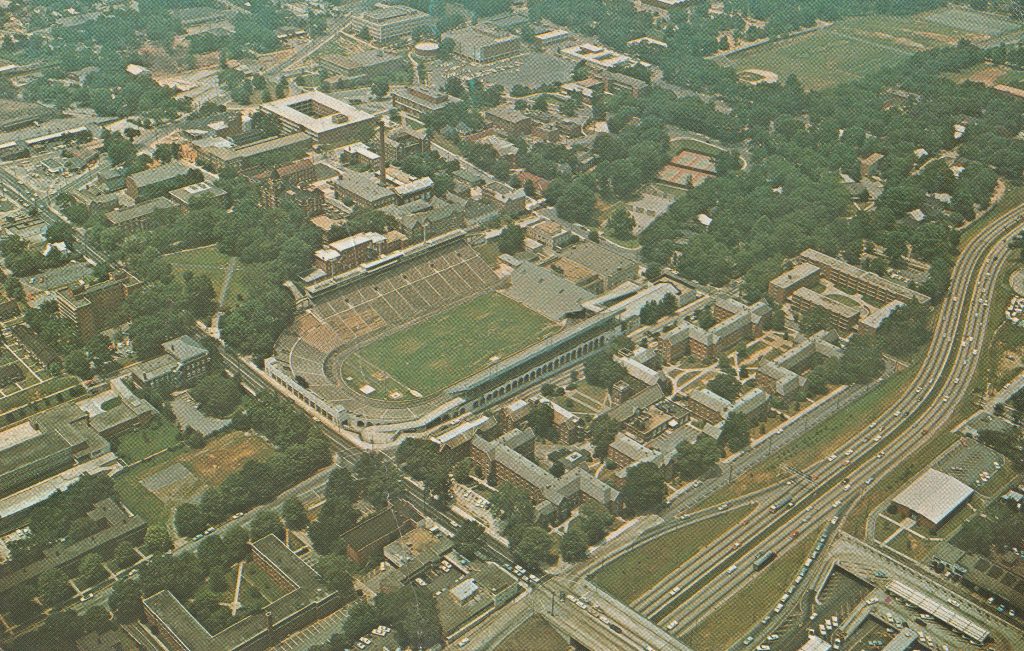
Bobby Dodd Stadium (named Grant Field from 1913 until 1988), the home field of Georgia Tech, sits at the edge of downtown Atlanta. It is one of the oldest college football stadiums in the South. The first section of the stadium was completed in 1913, much of it constructed by Georgia Tech students. It seated 5,600 fans in concrete stands on the west side of the field. In October 1916 on its home field, Georgia Tech defeated Cumberland College 222 to 0, the most lopsided game in college football history.
Concrete stands were added to the east side of the stadium for the 1924 season. The next year, seats were added to the south end zone to give the stadium a horseshoe shape and bring its capacity to 30,000. After World War II, the west stands were rebuilt and enlarged to increase seating to 44,000. A steel grandstand was erected in the north endzone to enclose the stadium in the late 1950s. In 1962 and 1968, upper decks were added to the east and west sides of the stadium respectively to increase the stadium’s capacity to 58,000.
Grant Field hosted the postseason Peach Bowl Game from its inaugural year in 1968 until 1970. In 1988, the stadium was renamed for Bobby Dowd, the winningest football coach in Georgia Tech history. Recent renovation projects to improve fan amenities decreased seating to its current capacity of 55,000. Today’s stadium no longer resembles the one portrayed on this early 1960s postcard.
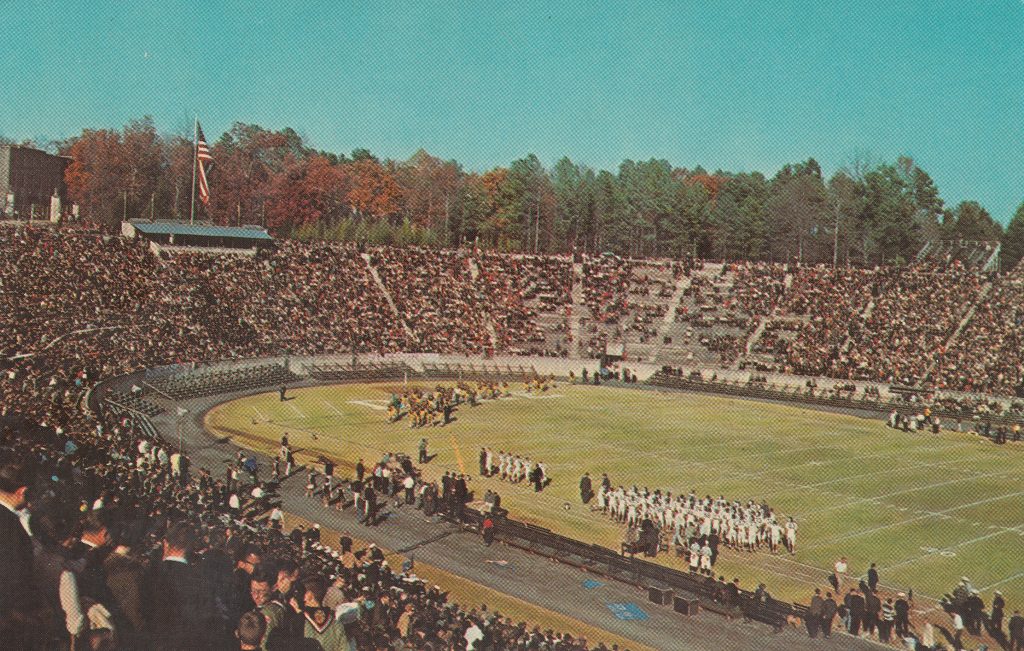
Duke University Stadium was built in 1929 but was renamed Wallace Wade Stadium in honor of Duke’s legendary former football coach in 1967. When it was built, the horseshoe shaped stadium seated approximately 34,000 fans.
On New Year’s Day 1942, Duke was scheduled to play the University of Oregon in the Rose Bowl in Pasadena. After the Japanese surprise attack on Pearl Harbor, U. S. military officials feared that a stadium filled with 90,000 spectators would be a prime target for Japanese bombers. General John DeWitt, the head of the Western Defense Command advised the Tournament of Roses Committee to cancel the game or move it from California. Oregon was out, since the government banned all large outdoor gatherings on the West Coast. Duke offered to host the game in Durham and Oregon accepted. The game was played on a cold and rainy New Year’s Day in front of 56,000 fans. Duke borrowed bleachers from the University of North Carolina and North Carolina State University to accommodate 22,000 spectators. Despite the home field advantage, Oregon defeated heavily favored Duke, 20 – 16.
Between 2014 and 2016, Wallace Wade Stadium was renovated and expanded. The Blue Devil Tower was constructed above the west stands to house 21 luxury suites, 516 club seats, and an expanded press/broadcasting box. The concourses were expanded to house improved restrooms and concessions. Today it seats 40,000 fans. The postcard here is from the early 1960s before the stadium was renamed.
This tour continues and concludes a few miles north of the Duke stadium in the state of Virginia with a look at Cary Field in Williamsburg and Foreman Field in Norfolk.
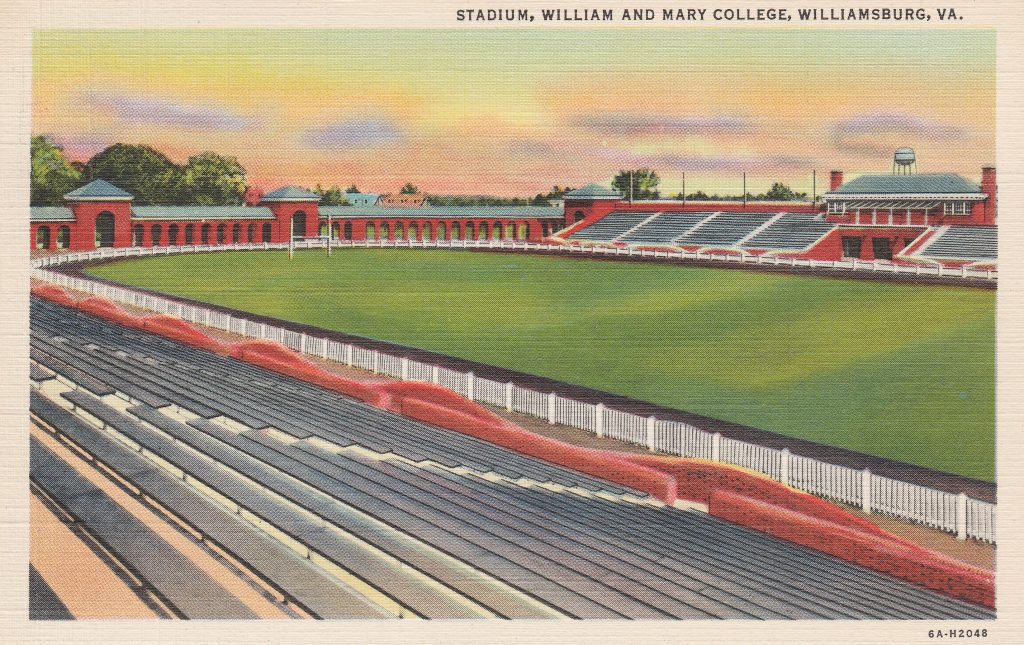
Completed in 1935, Cary Field is part of the College of William and Mary in Williamsburg. It is now named Walter J. Zable Stadium in honor of a 1930s William and Mary football star and generous benefactor to the college. Mr. Zable played in the first football game at Cary Field, the 1935 season opener, a 0-0 tie against the University of Virginia.
Cary Field followed the design of other William and Mary buildings, using Flemish bond brick, Georgian moldings and trim, at a cost of $138,395. The funding was provided by the New Deal’s Works Progress Administration (WPA). A graceful colonial style brick arcade enclosed the north end of the stadium. The original capacity was 12,000 bleacher seats.
WPA funding created a myth about an anomaly in the stadium’s design. The main entrance to the stadium is located on the 50 yard line of the east grandstand, eliminating 500 prime seats. Some years ago, an economics professor indicated that the entrance was located there because funding from the WPA could not be used to build athletic stadiums. Stadiums were required by the WPA to have other purposes. The entrance was situated at the 50 yard line to enable livestock exhibitions and auctions to be held at Cary Field. It sounded fishy since the south end of the stadium was not enclosed at the time, making it easy to move animals on and off the field. Extensive research by a reporter found no documentation in the college’s archives to support the livestock exhibition folklore and no livestock exhibitions were ever held at Cary Field. (Who would want to play football after a livestock exhibition?) The myth was chalked up to nothing more than urban legend since the WPA funded other stadium projects.
Like many college football stadiums built in the 1920s and 1930s, Cary Field lacked fan amenities and lights. Many college football stadiums did not have lights until the 1970s when the insatiable demand for college football by television broadcasters forced teams to move games from the traditional Saturday afternoon to evenings. Cary Field underwent a $28 million expansion and renovation between 2015 and 2016 and no longer resembles the humble 1935 stadium.
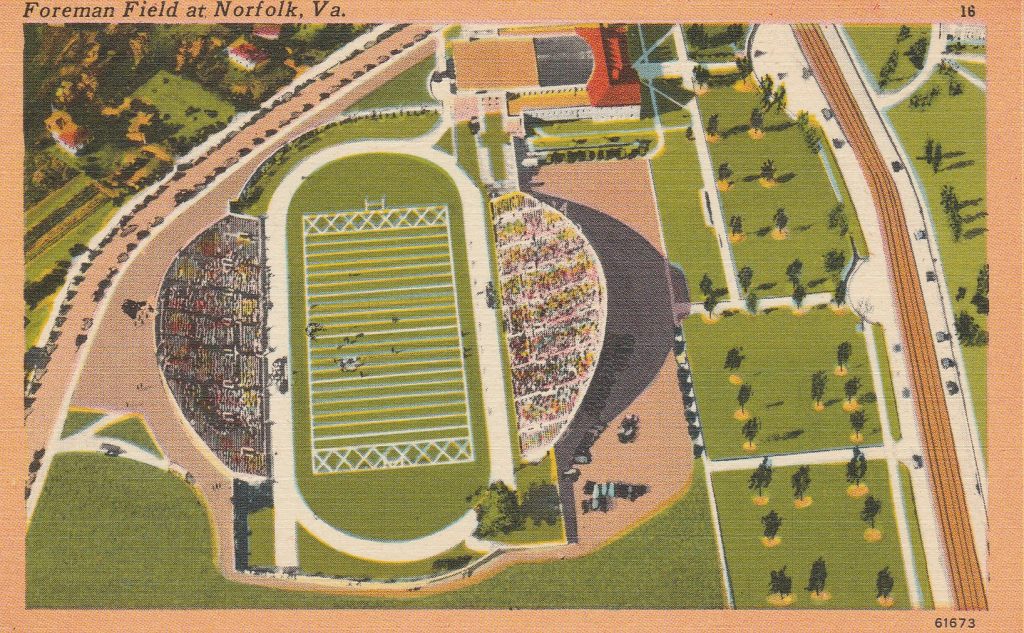
Foreman Field was built as a WPA project in 1936 on the campus of Old Dominion University in Norfolk, Virginia. It was a municipal stadium and initially seated 17,500. Bleachers added to the end zones in the 1950s increased capacity to 26,000. The Braves of the Norfolk Division of the College of William and Mary (ODU’s forerunner) played in Foreman Field from 1936 until 1940 when World War II forced discontinuation of the football team.
From 1946 until 1995, Foreman Field was the home of the Shrine Oyster Bowl featuring visiting college football teams primarily from the South although Pitt and Syracuse ventured south of the Mason–Dixon Line to participate. The most popular team to visit Norfolk were the Midshipmen of the U. S. Naval Academy. They played in nine Oyster Bowl Games between 1954 and 1972, winning five. The postcard shows an aerial view of a 1950s Oyster Bowl Game. Midshipmen are spelling NAVY along the east sideline.
The crosstown Norfolk State University Spartans played in Foreman Field from 1986 until 1996. Old Dominion University revived football in 2009 and Foreman Field received a new lease on life. Due to advancing age and lack of fan amenities, Foreman Field met the wrecking ball in 2018 and the S. B. Ballard Stadium was constructed in just nine months to replace it.
It has always fascinated an European audience how popular college football is in the USA. These postcards and the history gives a wonderful insight. Thank You.
Even in Canada – football is fairly popular on some small-town campuses but I live near the University of Toronto Varsity Blues football stadium, where 4,000 would be a great crowd these days.
Really enjoy your posts and learn a lot every time.
When the 1942 Rose Bowl was played in Durham, Duke lost to Oregon State, not Oregon, though I’m sure the Ducks would have preferred the rainy weather
More @postcardsfromdurham
I remember watching Dolphins home games in the 1970’s and reading the sign which proclaimed “The City of Miami welcomes you to the Orange Bowl”.
Great history on the expansion of the stadiums. Many great football games were played on these fields.
The 222-0 game would have been quite something. That would be 8 touchdowns a quarter or something like that (not sure if touchdowns counted 5 or 6 at that time). Did they even allow forward passing then?